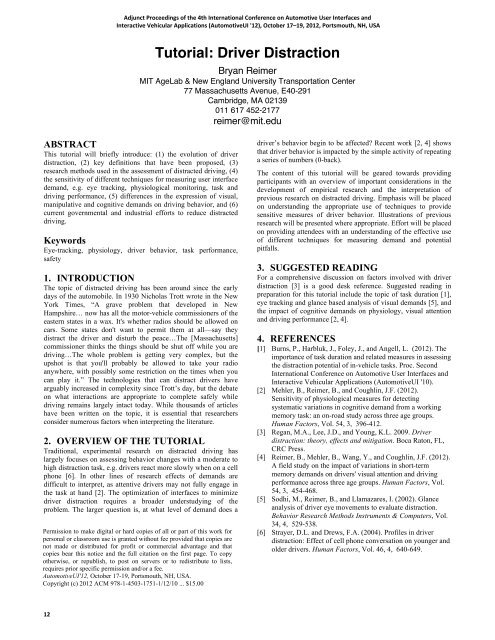12: Adjunct Proceedings - Automotive User Interfaces and ...
12: Adjunct Proceedings - Automotive User Interfaces and ...
12: Adjunct Proceedings - Automotive User Interfaces and ...
Create successful ePaper yourself
Turn your PDF publications into a flip-book with our unique Google optimized e-Paper software.
Tutorial: Driver Distraction<br />
Bryan Reimer<br />
MIT AgeLab & New Engl<strong>and</strong> University Transportation Center<br />
77 Massachusetts Avenue, E40-291<br />
Cambridge, MA 02139<br />
011 617 452-2177<br />
reimer@mit.edu<br />
ABSTRACT<br />
This tutorial will briefly introduce: (1) the evolution of driver<br />
distraction, (2) key definitions that have been proposed, (3)<br />
research methods used in the assessment of distracted driving, (4)<br />
the sensitivity of different techniques for measuring user interface<br />
dem<strong>and</strong>, e.g. eye tracking, physiological monitoring, task <strong>and</strong><br />
driving performance, (5) differences in the expression of visual,<br />
manipulative <strong>and</strong> cognitive dem<strong>and</strong>s on driving behavior, <strong>and</strong> (6)<br />
current governmental <strong>and</strong> industrial efforts to reduce distracted<br />
driving.<br />
Keywords<br />
Eye-tracking, physiology, driver behavior, task performance,<br />
safety<br />
1. INTRODUCTION<br />
The topic of distracted driving has been around since the early<br />
days of the automobile. In 1930 Nicholas Trott wrote in the New<br />
York Times, “A grave problem that developed in New<br />
Hampshire… now has all the motor-vehicle commissioners of the<br />
eastern states in a wax. It's whether radios should be allowed on<br />
cars. Some states don't want to permit them at all—say they<br />
distract the driver <strong>and</strong> disturb the peace…The [Massachusetts]<br />
commissioner thinks the things should be shut off while you are<br />
driving…The whole problem is getting very complex, but the<br />
upshot is that you'll probably be allowed to take your radio<br />
anywhere, with possibly some restriction on the times when you<br />
can play it.” The technologies that can distract drivers have<br />
arguably increased in complexity since Trott’s day, but the debate<br />
on what interactions are appropriate to complete safely while<br />
driving remains largely intact today. While thous<strong>and</strong>s of articles<br />
have been written on the topic, it is essential that researchers<br />
consider numerous factors when interpreting the literature.<br />
2. OVERVIEW OF THE TUTORIAL<br />
Traditional, experimental research on distracted driving has<br />
largely focuses on assessing behavior changes with a moderate to<br />
high distraction task, e.g. drivers react more slowly when on a cell<br />
phone [6]. In other lines of research effects of dem<strong>and</strong>s are<br />
difficult to interpret, as attentive drivers may not fully engage in<br />
the task at h<strong>and</strong> [2]. The optimization of interfaces to minimize<br />
driver distraction requires a broader understudying of the<br />
problem. The larger question is, at what level of dem<strong>and</strong> does a<br />
Permission to make digital or hard copies of all or part of this work for<br />
personal or classroom use is granted without fee provided that copies are<br />
not made or distributed for profit or commercial advantage <strong>and</strong> that<br />
copies bear this notice <strong>and</strong> the full citation on the first page. To copy<br />
otherwise, or republish, to post on servers or to redistribute to lists,<br />
requires prior specific permission <strong>and</strong>/or a fee.<br />
<strong>Automotive</strong>UI'<strong>12</strong>, October 17-19, Portsmouth, NH, USA.<br />
Copyright (c) 20<strong>12</strong> ACM 978-1-4503-1751-1/<strong>12</strong>/10 ... $15.00<br />
<strong>12</strong><br />
<strong>Adjunct</strong> <strong>Proceedings</strong> of the 4th International Conference on <strong>Automotive</strong> <strong>User</strong> <strong>Interfaces</strong> <strong>and</strong><br />
Interactive Vehicular Applications (<strong>Automotive</strong>UI '<strong>12</strong>), October 17–19, 20<strong>12</strong>, Portsmouth, NH, USA<br />
driver’s behavior begin to be affected? Recent work [2, 4] shows<br />
that driver behavior is impacted by the simple activity of repeating<br />
a series of numbers (0-back).<br />
The content of this tutorial will be geared towards providing<br />
participants with an overview of important considerations in the<br />
development of empirical research <strong>and</strong> the interpretation of<br />
previous research on distracted driving. Emphasis will be placed<br />
on underst<strong>and</strong>ing the appropriate use of techniques to provide<br />
sensitive measures of driver behavior. Illustrations of previous<br />
research will be presented where appropriate. Effort will be placed<br />
on providing attendees with an underst<strong>and</strong>ing of the effective use<br />
of different techniques for measuring dem<strong>and</strong> <strong>and</strong> potential<br />
pitfalls.<br />
3. SUGGESTED READING<br />
For a comprehensive discussion on factors involved with driver<br />
distraction [3] is a good desk reference. Suggested reading in<br />
preparation for this tutorial include the topic of task duration [1],<br />
eye tracking <strong>and</strong> glance based analysis of visual dem<strong>and</strong>s [5], <strong>and</strong><br />
the impact of cognitive dem<strong>and</strong>s on physiology, visual attention<br />
<strong>and</strong> driving performance [2, 4].<br />
4. REFERENCES<br />
[1] Burns, P., Harbluk, J., Foley, J., <strong>and</strong> Angell, L. (20<strong>12</strong>). The<br />
importance of task duration <strong>and</strong> related measures in assessing<br />
the distraction potential of in-vehicle tasks. Proc. Second<br />
International Conference on <strong>Automotive</strong> <strong>User</strong> <strong>Interfaces</strong> <strong>and</strong><br />
Interactive Vehicular Applications (<strong>Automotive</strong>UI '10).<br />
[2] Mehler, B., Reimer, B., <strong>and</strong> Coughlin, J.F. (20<strong>12</strong>).<br />
Sensitivity of physiological measures for detecting<br />
systematic variations in cognitive dem<strong>and</strong> from a working<br />
memory task: an on-road study across three age groups.<br />
Human Factors, Vol. 54, 3, 396-4<strong>12</strong>.<br />
[3] Regan, M.A., Lee, J.D., <strong>and</strong> Young, K.L. 2009. Driver<br />
distraction: theory, effects <strong>and</strong> mitigation. Boca Raton, FL,<br />
CRC Press.<br />
[4] Reimer, B., Mehler, B., Wang, Y., <strong>and</strong> Coughlin, J.F. (20<strong>12</strong>).<br />
A field study on the impact of variations in short-term<br />
memory dem<strong>and</strong>s on drivers' visual attention <strong>and</strong> driving<br />
performance across three age groups. Human Factors, Vol.<br />
54, 3, 454-468.<br />
[5] Sodhi, M., Reimer, B., <strong>and</strong> Llamazares, I. (2002). Glance<br />
analysis of driver eye movements to evaluate distraction.<br />
Behavior Research Methods Instruments & Computers, Vol.<br />
34, 4, 529-538.<br />
[6] Strayer, D.L. <strong>and</strong> Drews, F.A. (2004). Profiles in driver<br />
distraction: Effect of cell phone conversation on younger <strong>and</strong><br />
older drivers. Human Factors, Vol. 46, 4, 640-649.





